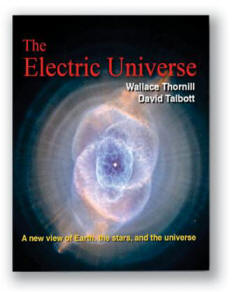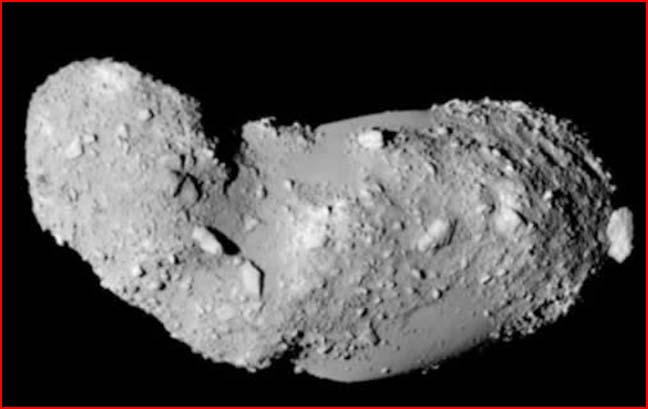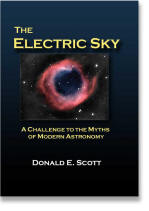
home •
about •
essential guide •
picture of the day •
thunderblogs •
news •
multimedia •
predictions •
products •
get involved •
contact
picture of the day archive subject index
Image of the asteroid Itokawa (25143), taken by Japan’s probe
Hayabusa, reveals a rugged surface of collected dust and debris.
Credit: JAXA
Mar 28, 2006
Asteroid ItokawaThe sharp contrast between the surfaces of some asteroids and comets is underscored by recent images of asteroid Itokawa. For the electrical theorists, the contrast also illustrates the crucial distinction between electrical deposition and electrical excavation.
In the fall of 2005, the Japanese asteroid probe Hayabusa approached the S-type (silicaceous/stony) asteroid Itokawa (25143), named after the Japanese rocket scientist Hideo Itokawa. Though the probe was unable to complete two planned landings to gather dust samples from the asteroid, it did produce high quality pictures of the asteroid’s surface that are now the subject of much debate among astronomers.
As the electrical theorists see it, asteroids, comets, and meteors, are all born by being torn from a planetary surface in a cosmic plasma discharge or as the remains of rocky bodies that exploded under the extreme electrical stresses. The asteroid’s irregular shape is explicable because plasma discharges are known to create “dumbbell” or “potato” shaped forms from soils. The comet Halley is another well-known potato shaped body. But crucial distinctions must be made between comets and asteroids under the electrical interpretation of their origin— distinctions that are meaningless under conventional definitions of such bodies.
• The planetary soil and rock that is hurled into space will be modified by its degree of exposure to the plasma discharge. This is evident in the most abundant meteorites – the chondritic meteorites, so named for the melted spherules found within their dusty matrix. Some scientists have acknowledged that the best explanation for their origin is in a cosmic “lightning flash”. The velocity imparted to the excavated material will determine whether it becomes an asteroid or a comet. (The astronomer Tom Van Flandern has argued, on the basis of their orbital characteristics, that comets were formed by the explosion of a planet in the asteroid belt).
• Itokawa’s density is said to be less than expected—up to 39% empty space. So researchers concluded it is probably composed of smaller rocks that are held together by gravity. However, this conclusion rests on an untested assumption that the gravitational 'constant' we measure on Earth is the same for all other bodies. In fact, it doesn't seem to be constant on Earth!
We have now seen many dark, rocky bodies in space have such low apparent densities that astronomers have been forced to conclude they are “mostly empty space”. But the electrical model of gravity suggests that if it looks like solid rock, it probably is solid rock. The internal electrical state of comets and meteorites differs from the Earth, and this leads to erroneous calculations of their densities. Astronomers have yet to reckon with the electrical origin of gravity. (The most glaring example is the giant planet Saturn which, on the astronomers’ calculations, should float on water, if that were possible!)
• Astronomers expressed surprise at the absence of “impact craters” in the Itokawa photos. (In fact, there appear to be no craters on Itokawa, in contrast to the many craters seen on other asteroids). This has caused some to suggest that the asteroid is a “rubble pile”. But the electric model suggests that asteroids, like chondritic meteorites, may tend to aggregate material electrostatically. Asteroids that have no cratering (Itokawa being the case par excellence) are more likely to have acquired a boulder-strewn surface subsequent to their violent birth, but that does not make them just a heap of rubble.
• An active comet will experience electrical etching of its surface. Surface material will be removed and new craters formed. The comet will be “electrostatically cleaned”—a prediction we made for Comet Tempel 1 in advance of the “Deep Impact” encounter with the comet. The contrast between the surface of Tempel 1 and that of Itokawa adds an exclamation point to this prediction.
In the electric model comets, asteroids, and meteorites originated in either the same or similar events. The model thus predicts that, as we come to learn more about comets and asteroids, we will see that their compositional types match those of meteorites, a class of objects that has been well studied.
__________________________________________________________________________Please visit our new "Thunderblog" page
Through the initiative of managing editor Dave Smith, we’ve begun the launch of a new
page called Thunderblog. Timely presentations of fact and opinion, with emphasis on
new discoveries and the explanatory power of the Electric Universe."The Electric Sky and The Electric Universe available now!

|
|

|
EXECUTIVE EDITORS:
David Talbott, Wallace Thornhill
MANAGING EDITOR:
Michael Armstrong
CONTRIBUTING EDITORS: Dwardu Cardona, Ev Cochrane,
C.J. Ransom, Don Scott, Rens van der Sluijs, Ian Tresman
WEBMASTER: Michael Armstrong
Copyright 2006: thunderbolts.info
![]()
home •
thunderblogs •
forum •
picture of the day •
resources •
team •
updates •
contact us

